A Road towards 6G Communication—A Review of 5G Antennas, Arrays, and Wearable Devices
Abstract
1. Introduction
2. Towards 6G Communication System
2.1. Key Features
- Connectivity: One of the key features of the transition from 5G to 6G is massive connectivity. A massive number of IoTs are expected to be connected with each other either in line of sight or non-line of sight scenarios. Uninterrupted connectivity will be achieved using artificial-intelligent-assisted reconfigurable meta-surfaces. Connectivity in large areas is expected to be achieved using integrated satellite and 5G networks.
- Mobility: Intelligent transport systems with very high speed are expected. Ultra-low latency in data communication will improve the transportation system. The peak speed that is considered in 6G is 1000 Km/h for airline communication scenarios, which is much higher than 5G [31].
- Security: Data privacy and security are essential aspects of any communication system, especially in the defense and banking sectors, as shown in Figure 3. By applying deep learning and artificial intelligence technologies in physical and network layers, the security will be improved in deceives, infrastructures, and assets in 6G networks.
- Broadcasting: New multimedia services and infrastructures with the focus on ultra-high video streaming, live broadcasting, and entertainment will be available in 6G. That excellent quality of service will be achieved by a mixture of satellites, cables, and mobile technologies.
- Ubiquity: The coverage area is expected to be larger compared to 5G systems. The 6G systems will include space and maritime communication along with ground-based communication to achieve large coverage and higher data rates. It will be available using a combination of GEO/LEO satellite and terrestrial networks. This is very important, especially for communication in aeroplanes, ships, and people living/working in remote areas.
- Data Rates: According to Shannon’s equation, the data rates directly proportional to capacity can be improved by enhancing bandwidth and the number of antennas. The mm-wave/THz bands provide significantly high bandwidth from 1 to 10 GHz. Hence, both techniques, a massive number of antennas and a Mm-wave/THz band, are direct methods to achieve a higher demand of data rates. It is expected to achieve 1 Tbps, which is higher than 5G in both up and downlinks [6,31]. The higher data rates are significant in almost all sectors, including ultra-high-definition video streaming, large data files in offices, etc.
2.2. The 6G Frequency Spectrums
3. 5G Antennas, Arrays, and Wearable Devices
3.1. Antennas for 5G Handheld Devices
3.1.1. 5G Antennas according to Operational Approach
Beam Steerable Antenna
B. Switchable Phased Array
Dual Polarized Antenna
3.1.2. 5G Antennas according to the Operational Frequency Band
Sub-6 GHz 5G Antennas
mm-Wave Antennas
Sub 6 GHz and mm-Wave Antennas
3.2. Antennas for 5G Access Points
3.3. Antennas at THz Frequency Bands
3.4. 5G Wearable Antennas
3.4.1. Sub-6 GHz 5G Wearable Antennas
3.4.2. mm-Wave 5G Wearable Antennas
4. Conclusions
Author Contributions
Funding
Institutional Review Board Statement
Informed Consent Statement
Data Availability Statement
Acknowledgments
Conflicts of Interest
References
- Giordani, M.; Polese, M.; Mezzavilla, M.; Rangan, S.; Zorzi, M. Toward 6G Networks: Use Cases and Technologies. IEEE Commun. Mag. 2020, 58, 55–61. [Google Scholar] [CrossRef]
- Gui, G.; Liu, M.; Tang, F.; Kato, N.; Adachi, F. 6G: Opening new horizons for integration of comfort, security, and intelligence. IEEE Wirel. Commun. 2020, 27, 126–132. [Google Scholar] [CrossRef]
- Ikram, M. Multi-Functional Antenna Structures for 4G/5G Wireless Communication Devices. Ph.D. Thesis, The University of Queensland, Brisbane, Australia, 2021. [Google Scholar]
- Hong, W. Solving the 5G Mobile Antenna Puzzle: Assessing Future Directions for the 5G Mobile Antenna Paradigm Shift. IEEE Microw. Mag. 2017, 18, 86–102. [Google Scholar] [CrossRef]
- Jornet, J.M.; Akyildiz, I.F. Channel Modeling and Capacity Analysis for Electromagnetic Wireless Nanonetworks in the Terahertz Band. IEEE Trans. Wirel. Commun. 2011, 10, 3211–3221. [Google Scholar] [CrossRef]
- Rajatheva, N.; Atzeni, I.; Bjornson, E.; Bourdoux, A.; Buzzi, S.; Dore, J.B.; Erkucuk, S.; Fuentes, M.; Guan, K.; Hu, Y.; et al. White paper on broadband connectivity in 6G. arXiv 2020, arXiv:2004.14247. [Google Scholar]
- Bang, J.; Choi, J. A SAR Reduced mm-Wave Beam-Steerable Array Antenna With Dual-Mode Operation for Fully Metal-Covered 5G Cellular Handsets. IEEE Antennas Wirel. Propag. Lett. 2018, 17, 1118–1122. [Google Scholar] [CrossRef]
- Buey, C. Design and Measurement of Multi-Antenna Systems toward Future 5G Technologies. Ph.D. Thesis, Université Côte d’Azur, Nice, France, 2018. [Google Scholar]
- Deckmyn, T.; Cauwe, M.; Ginste, D.V.; Rogier, H.; Agneessens, S. Dual-band (28,38) GHz coupled quarter-mode sub-strate-integrated waveguide antenna array for next-generation wireless systems. IEEE Trans. Antennas Propag. 2019, 67, 2405–2412. [Google Scholar] [CrossRef]
- Ikram, M.; Hussain, R.; Sharawi, M.S. 4G/5G antenna system with dual function planar connected array. IET Microw. Antennas Propag. 2017, 11, 1760–1764. [Google Scholar] [CrossRef]
- Krishna, S. Design and Development of 5G Spectrum Massive MIMO Array Antennas for Base Station and Access Point Applications. Ph.D. Thesis, San Diego State University, San Diego, CA, USA, 2018. [Google Scholar]
- Løvaas, H.G.D. Multiband UWB Antenna Design for WiFi, LTE and 5G. Master’s Thesis, The Norwegian University of Science and Technology, Trondheim, Norway, 2017. [Google Scholar]
- Ojaroudiparchin, N.; Shen, M.; Zhang, S.; Pedersen, G.F. A Switchable 3-D-Coverage-Phased Array Antenna Package for 5G Mobile Terminals. IEEE Antennas Wirel. Propag. Lett. 2016, 15, 1747–1750. [Google Scholar] [CrossRef]
- Parchin, N.O.; Al-Yasir, Y.; Ali, A.H.; Elfergani, I.; Noras, J.M.; Rodriguez, J.; Abd-Alhameed, R.A. Eight-Element Dual-Polarized MIMO Slot Antenna System for 5G Smartphone Applications. IEEE Access 2019, 7, 15612–15622. [Google Scholar] [CrossRef]
- Salous, S.; Degli Esposti, V.; Fuschini, F.; Thomae, R.S.; Mueller, R.; Dupleich, D.; Haneda, K.; Garcia-Pardo, J.M.M.; Garcia, J.P.; Gaillot, D.P.; et al. Millimeter-wave propagation: Characterization and modeling toward fifth-generation systems. IEEE Antennas Propag. Mag. 2016, 58, 115–127. [Google Scholar] [CrossRef]
- Zhao, A.; Ren, Z. Size Reduction of Self-Isolated MIMO Antenna System for 5G Mobile Phone Applications. IEEE Antennas Wirel. Propag. Lett. 2018, 18, 152–156. [Google Scholar] [CrossRef]
- Chataut, R.; Akl, R. Massive MIMO systems for 5G and beyond networks—Overview, recent trends, challenges, and future research direction. Sensors 2020, 20, 2753. [Google Scholar] [CrossRef] [PubMed]
- You, L.; Li, K.X.; Wang, J.; Gao, X.; Xia, X.G.; Ottersten, B. Massive MIMO transmission for LEO satellite communications. IEEE J. Sel. Areas Commun. 2020, 38, 1851–1865. [Google Scholar] [CrossRef]
- Liu, P.; Li, Y.; Cheng, W.; Gao, X.; Zhang, W. Multi-Beam NOMA for Millimeter-Wave Massive MIMO with Lens Antenna Array. IEEE Trans. Veh. Technol. 2020, 69, 11570–11583. [Google Scholar] [CrossRef]
- Basenese, L. 5 Reasons to Let It Ride on 5G. Available online: https://www.smarteranalyst.com/bloggers-corner/resonant-resn-5-reasons-to-let-it-ride-on-5g/ (accessed on 1 March 2019).
- Björnson, E.; Sanguinetti, L.; Wymeersch, H.; Hoydis, J.; Marzetta, T.L. Massive MIMO is a reality—What is next?: Five promising research directions for antenna arrays. Digit. Signal Process. 2019, 94, 3–20. [Google Scholar] [CrossRef]
- Yon, H.; Rahman, N.H.A.; Aris, M.A.; Jamaluddin, M.H.; Lin, I.K.C.; Jumaat, H.; Redzwan, F.N.M.; Yamada, Y. Development of C-Shaped Parasitic MIMO Antennas for Mutual Coupling Reduction. Electronics 2021, 10, 2431. [Google Scholar] [CrossRef]
- Farasat, M.; Thalakotuna, D.N.; Hu, Z.; Yang, Y. A Review on 5G Sub-6 GHz Base Station Antenna Design Challenges. Electronics 2021, 10, 2000. [Google Scholar] [CrossRef]
- Hassan, A.K.; Moinuddin, M.; Al-Saggaf, U.M.; Aldayel, O.; Davidson, T.N.; Al-Naffouri, T.Y. Performance Analysis and Joint Statistical Beamformer Design for Multi-User MIMO Systems. IEEE Commun. Lett. 2020, 24, 2152–2156. [Google Scholar] [CrossRef]
- Hassan, A.K.; Moinuddin, M.; Al-Saggaf, U.M.; Al-Naffouri, T.Y. Performance Analysis of Beamforming in MU-MIMO Systems for Rayleigh Fading Channels. IEEE Access 2017, 5, 3709–3720. [Google Scholar] [CrossRef]
- Siddique, U.; Tabassum, H.; Hossain, E.; Kim, D.I. Wireless backhauling of 5G small cells: Challenges and solution approaches. IEEE Wirel. Commun. 2015, 22, 22–31. [Google Scholar] [CrossRef]
- Bariah, L.; Mohjazi, L.; Muhaidat, S.; Sofotasios, P.C.; Kurt, G.K.; Yanikomeroglu, H.; Dobre, O.A. A Prospective Look: Key Enabling Technologies, Applications and Open Research Topics in 6G Networks. IEEE Access 2020, 8, 174792–174820. [Google Scholar] [CrossRef]
- Giambene, G.; Kota, S.; Pillai, P. Satellite-5G Integration: A Network Perspective. IEEE Netw. 2018, 32, 25–31. [Google Scholar] [CrossRef]
- Schwarz, R.T.; Delamotte, T.; Storek, K.-U.; Knopp, A. MIMO Applications for Multibeam Satellites. IEEE Trans. Broadcast. 2019, 65, 664–681. [Google Scholar] [CrossRef]
- Sultan, K.S.; Abdullah, H.H.; Abdallah, E.A.; El-Hennawy, H.S. Metasurface-Based Dual Polarized MIMO Antenna for 5G Smartphones Using CMA. IEEE Access 2020, 8, 37250–37264. [Google Scholar] [CrossRef]
- Jiang, W.; Han, B.; Habibi, M.A.; Schotten, H.D. The Road Towards 6G: A Comprehensive Survey. IEEE Open J. Commun. Soc. 2021, 2, 334–366. [Google Scholar] [CrossRef]
- Li, A.; Luk, K.-M.; Li, Y. A Dual Linearly Polarized End-Fire Antenna Array for the 5G Applications. IEEE Access 2018, 6, 78276–78285. [Google Scholar] [CrossRef]
- Alhalabi, R.A.; Rebeiz, G.M. High-Efficiency Angled-Dipole Antennas for Millimeter-Wave Phased Array Applications. IEEE Trans. Antennas Propag. 2008, 56, 3136–3142. [Google Scholar] [CrossRef]
- Hussain, R.; Alreshaid, A.T.; Podilchak, S.K.; Sharawi, M.S. Compact 4G MIMO antenna integrated with a 5G array for current and future mobile handsets. IET Microw. Antennas Propag. 2017, 11, 271–279. [Google Scholar] [CrossRef]
- Ta, S.X.; Choo, H.; Park, I. Broadband Printed-Dipole Antenna and Its Arrays for 5G Applications. IEEE Antennas Wirel. Propag. Lett. 2017, 16, 2183–2186. [Google Scholar] [CrossRef]
- Ala-Laurinaho, J.; Aurinsalo, J.; Karttunen, A.; Kaunisto, M.; Lamminen, A.; Nurmiharju, J.; Raisanen, A.V.; Saily, J.; Wainio, P. 2D Beam-Steerable Integrated Lens Antenna System for 5G E-Band Access and Backhaul. IEEE Trans. Microw. Theory Tech. 2016, 64, 2244–2255. [Google Scholar] [CrossRef]
- Taheri, M.M.S.; Abdipour, A.; Zhang, S.; Pedersen, G.F. Integrated Millimeter-Wave Wideband End-Fire 5G Beam Steerable Array and Low-Frequency 4G LTE Antenna in Mobile Terminals. IEEE Trans. Veh. Technol. 2019, 68, 4042–4046. [Google Scholar] [CrossRef]
- Tanaka, H.; Ohira, T. Beam-steerable planar array antennas using varactor diodes for 60-GHz-band applications. In Proceedings of the 33rd European Microwave Conference Proceedings (IEEE Cat. No.03EX723C), Munich, Germany, 7 October 2003; Volume 3, pp. 1067–1070. [Google Scholar]
- Tanaka, H.; Ohira, T. A single-planar integrated self-heterodyne receiver with a built-in beam-steerable array antenna for 60-GHz-band video transmission systems. In Proceedings of the IEEE MTT-S International Microwave Symposium Digest (IEEE Cat. No.04CH37535), Fort Worth, TX, USA, 6–11 June 2004; Volume 2, pp. 735–738. [Google Scholar]
- Wu, P.; Chen, S. Design of beam-steerable dual-beam reflectarray. In Proceedings of the 2017 IEEE International Symposium on Antennas and Propagation & USNC/URSI National Radio Science Meeting, San Diego, CA, USA, 9–14 July 2017; pp. 2081–2082. [Google Scholar]
- Yazid, Y.; Xun, G. Beam-steerable patch antenna array using parasitic coupling and reactive loading. In Proceedings of the 2007 IEEE Antennas and Propagation Society International Symposium, Honolulu, HI, USA, 9–15 June 2007; pp. 4693–4696. [Google Scholar]
- Zhang, S.; Syrytsin, I.; Pedersen, G.F. Compact Beam-Steerable Antenna Array with Two Passive Parasitic Elements for 5G Mobile Terminals at 28 GHz. IEEE Trans. Antennas Propag. 2018, 66, 5193–5203. [Google Scholar] [CrossRef]
- Chen, Q.; Zhang, H. Dual-Patch Polarization Conversion Metasurface-Based Wideband Circular Polarization Slot Antenna. IEEE Access 2018, 6, 74772–74777. [Google Scholar] [CrossRef]
- Chu, H.-L. Investigations and Design of Wideband Dual Linear Polarized Massive MIMO Panel Array Antenna for 5G Communication Applications. Ph.D. Thesis, San Diego State University, San Diego, CA, USA, 2018. [Google Scholar]
- Hu, X.; Yan, S.; VandenBosch, G.A.E. Compact Circularly Polarized Wearable Button Antenna with Broadside Pattern for U-NII Worldwide Band Applications. IEEE Trans. Antennas Propag. 2018, 67, 1341–1345. [Google Scholar] [CrossRef]
- Li, A.; Luk, K. Millimeter-wave dual linearly polarized end-fire antenna fed by 180-degree hybrid coupler. IEEE Antennas Wirel. Propag. Lett. 2019, 18, 1390–1394. [Google Scholar] [CrossRef]
- Li, H.; Kang, L.; Wei, F.; Cai, Y.-M.; Yin, Y.-Z. A Low-Profile Dual-Polarized Microstrip Antenna Array for Dual-Mode OAM Applications. IEEE Antennas Wirel. Propag. Lett. 2017, 16, 3022–3025. [Google Scholar] [CrossRef]
- Wang, C.; Chen, Y.; Yang, S. Bandwidth Enhancement of a Dual-Polarized Slot Antenna Using Characteristic Modes. IEEE Antennas Wirel. Propag. Lett. 2018, 17, 988–992. [Google Scholar] [CrossRef]
- Li, M.Y.; Ban, Y.L.; Xu, Z.Q.; Wu, G.; Kang, K.; Yu, Z.F. Eight-port orthogonally dual-polarized antenna array for 5G smartphone applications. IEEE Trans. Antennas Propag. 2016, 64, 3820–3830. [Google Scholar] [CrossRef]
- Huang, H.; Li, X.; Liu, Y. A Low-Profile, Dual-Polarized Patch Antenna for 5G MIMO Application. IEEE Trans. Antennas Propag. 2018, 67, 1275–1279. [Google Scholar] [CrossRef]
- Li, M.; Xu, Z.; Ban, Y.; Sim, C.; Yu, Z. Eight-port orthogonally dual-polarised MIMO antennas using loop structures for 5G smartphone. IET Microw. Antennas Propag. 2017, 11, 1810–1816. [Google Scholar] [CrossRef]
- Wang, J.; Wang, W.; Liu, A.; Guo, M.; Wei, Z. Cross-Polarization Suppression of a Dual-Polarized Microstrip Antenna Using Enclosed Substrate-Integrated Cavities. IEEE Antennas Wirel. Propag. Lett. 2019, 19, 64–68. [Google Scholar] [CrossRef]
- Liu, D.; Gu, X.; Baks, C.W.; Valdes-Garcia, A. Antenna-in-package design considerations for Ka-band 5G communication ap-plications. IEEE Trans. Antennas Propag. 2017, 65, 6372–6379. [Google Scholar] [CrossRef]
- Wu, C.; Lu, C.; Cao, W. Wideband Dual Polarization Slot Antenna with High Isolation by Using Microstrip Line Balun Feed. IEEE Antennas Wirel. Propag. Lett. 2017, 16, 1759–1762. [Google Scholar] [CrossRef]
- Zhang, J.; Zhao, K.; Wang, L.; Zhang, S.; Pedersen, G.F. Dual-Polarized Phased Array with End-Fire Radiation for 5G Handset Applications. IEEE Trans. Antennas Propag. 2019, 68, 3277–3282. [Google Scholar] [CrossRef]
- Zhang, J.; Lin, X.Q.; Nie, L.Y.; Yu, J.W.; Fan, Y. Wideband Dual-Polarization Patch Antenna Array with Parallel Strip Line Balun Feeding. IEEE Antennas Wirel. Propag. Lett. 2016, 15, 1499–1501. [Google Scholar] [CrossRef]
- Li, Y.; Sim, C.-Y.; Luo, Y.; Yang, G. High-Isolation 3.5 GHz Eight-Antenna MIMO Array Using Balanced Open-Slot Antenna Element for 5G Smartphones. IEEE Trans. Antennas Propag. 2019, 67, 3820–3830. [Google Scholar] [CrossRef]
- Hsu, Y.W.; Huang, T.C.; Lin, H.S.; Lin, Y.C. Dual-polarized quasi yagiuda antennas with endfire radiation for millimeter-wave MIMO terminals. IEEE Trans. Antennas Propag. 2017, 65, 6282–6289. [Google Scholar] [CrossRef]
- Guo, J.; Cui, L.; Li, C.; Sun, B. Side-Edge Frame Printed Eight-Port Dual-Band Antenna Array for 5G Smartphone Applications. IEEE Trans. Antennas Propag. 2018, 66, 7412–7417. [Google Scholar] [CrossRef]
- Al Abbas, E.; Ikram, M.; Mobashsher, A.T.; Abbosh, A. MIMO Antenna System for Multi-Band Millimeter-Wave 5G and Wideband 4G Mobile Communications. IEEE Access 2019, 7, 181916–181923. [Google Scholar] [CrossRef]
- Zhang, X.; Li, Y.; Wang, W.; Shen, W. Ultra-Wideband 8-Port MIMO Antenna Array for 5G Metal-Frame Smartphones. IEEE Access 2019, 7, 72273–72282. [Google Scholar] [CrossRef]
- Zhao, A.; Ren, Z. Wideband MIMO Antenna Systems Based on Coupled-Loop Antenna for 5G N77/N78/N79 Applications in Mobile Terminals. IEEE Access 2019, 7, 93761–93771. [Google Scholar] [CrossRef]
- Zhao, X.; Yeo, S.P.; Ong, L.C. Decoupling of Inverted-F Antennas with High-Order Modes of Ground Plane for 5G Mobile MIMO Platform. IEEE Trans. Antennas Propag. 2018, 66, 4485–4495. [Google Scholar] [CrossRef]
- Ren, A.; Liu, Y.; Sim, C.-Y. A Compact Building Block with Two Shared-Aperture Antennas for Eight-Antenna MIMO Array in Metal-Rimmed Smartphone. IEEE Trans. Antennas Propag. 2019, 67, 6430–6438. [Google Scholar] [CrossRef]
- Di Paola, C.; Zhang, S.; Zhao, K.; Ying, Z.; Bolin, T.; Pedersen, G.F. Wideband Beam-Switchable 28 GHz Quasi-Yagi Array for Mobile Devices. IEEE Trans. Antennas Propag. 2019, 67, 6870–6882. [Google Scholar] [CrossRef]
- Zhu, S.; Liu, H.; Chen, Z.; Wen, P. A Compact Gain-Enhanced Vivaldi Antenna Array with Suppressed Mutual Coupling for 5G mmWave Application. IEEE Antennas Wirel. Propag. Lett. 2018, 17, 776–779. [Google Scholar] [CrossRef]
- Kulkarni, J.; Alharbi, A.G.; Desai, A.; Sim, C.-Y.; Poddar, A. Design and Analysis of Wideband Flexible Self-Isolating MIMO Antennas for Sub-6 GHz 5G and WLAN Smartphone Terminals. Electronics 2021, 10, 3031. [Google Scholar] [CrossRef]
- Ali, H.; Ren, X.-C.; Hashmi, A.M.; Anjum, M.R.; Bari, I.; Majid, S.I.; Jan, N.; Tareen, W.U.K.; Iqbal, A.; Khan, M.A. An Eight Element Dual Band Antenna for Future 5G Smartphones. Electronics 2021, 10, 3022. [Google Scholar] [CrossRef]
- Ban, Y.-L.; Li, C.; Sim, C.-Y.-D.; Wu, G.; Wong, K.-L. 4G/5G Multiple Antennas for Future Multi-Mode Smartphone Applications. IEEE Access 2016, 4, 2981–2988. [Google Scholar] [CrossRef]
- Chen, Q.; Lin, H.; Wang, J.; Ge, L.; Li, Y.; Pei, T.; Sim, C.-Y. Single Ring Slot-Based Antennas for Metal-Rimmed 4G/5G Smartphones. IEEE Trans. Antennas Propag. 2018, 67, 1476–1487. [Google Scholar] [CrossRef]
- Fakih, M.A.; Diallo, A.; Le Thuc, P.; Staraj, R.; Mourad, O.; Rachid, E.A. Optimization of Efficient Dual Band PIFA System for MIMO Half-Duplex 4G/LTE and Full-Duplex 5G Communications. IEEE Access 2019, 7, 128881–128895. [Google Scholar] [CrossRef]
- Huang, D.; Du, Z.; Wang, Y. A Quad-Antenna System for 4G/5G/GPS Metal Frame Mobile Phones. IEEE Antennas Wirel. Propag. Lett. 2019, 18, 1586–1590. [Google Scholar] [CrossRef]
- Ikram, M.; Al Abbas, E.; Nguyen-Trong, N.; Sayidmarie, K.H.; Abbosh, A. Integrated Frequency-Reconfigurable Slot Antenna and Connected Slot Antenna Array for 4G and 5G Mobile Handsets. IEEE Trans. Antennas Propag. 2019, 67, 7225–7233. [Google Scholar] [CrossRef]
- Ikram, M.; Nguyen-Trong, N.; Abbosh, A. Hybrid Antenna Using Open-Ended Slot for Integrated 4G/5G Mobile Application. IEEE Antennas Wirel. Propag. Lett. 2020, 19, 710–714. [Google Scholar] [CrossRef]
- Liu, Y.; Li, Y.; Ge, L.; Wang, J.; Ai, B. A Compact Hepta-Band Mode-Composite Antenna for Sub (6, 28, and 38) GHz Applications. IEEE Trans. Antennas Propag. 2020, 68, 2593–2602. [Google Scholar] [CrossRef]
- Naqvi, S.I.; Naqvi, A.H.; Arshad, F.; Riaz, M.A.; Azam, M.A.; Khan, M.; Amin, Y.; Loo, J.; Tenhunen, H. An Integrated Antenna System for 4G and Millimeter-Wave 5G Future Handheld Devices. IEEE Access 2019, 7, 116555–116566. [Google Scholar] [CrossRef]
- Yassin, M.E.; Mohamed, H.A.; Abdallah, E.A.; El-Hennawy, H.S. Single-fed 4G/5G multiband 2.4/5.5/28 GHz antenna. IET Microw. Antennas Propag. 2019, 13, 286–290. [Google Scholar] [CrossRef]
- Singh, H.; Mittal, N.; Gupta, A.; Kumar, Y.; Woźniak, M.; Waheed, A. Metamaterial Integrated Folded Dipole Antenna with Low SAR for 4G, 5G and NB-IoT Applications. Electronics 2021, 10, 2612. [Google Scholar] [CrossRef]
- Sultan, K.S.; Abdullah, H.H.; Abdallah, E.A. Comprehensive study of printed antenna with the handset modeling. Microw. Opt. Technol. Lett. 2016, 58, 974–980. [Google Scholar] [CrossRef]
- Chen, A.; Sun, M.; Zhang, Z.; Fu, X. Planar Monopole Antenna with a Parasitic Shorted Strip for Multistandard Handheld Terminals. IEEE Access 2020, 8, 51647–51652. [Google Scholar] [CrossRef]
- Mohamed, H.A.; Sultan, K. Quad band monopole antenna for IoT applications. In Proceedings of the 2018 IEEE International Symposium on Antennas and Propagation & USNC/URSI National Radio Science Meeting, Boston, MA, USA, 8–13 July 2018; pp. 1015–1016. [Google Scholar]
- Sultan, K.S.; Abdullah, H.H.; Abdallah, E.A.; Hashish, E.A. Low-SAR, miniaturized printed antenna for mobile, ISM, and WLAN services. IEEE Antennas Wirel. Propag. Lett. 2013, 12, 1106–1109. [Google Scholar] [CrossRef]
- Zuo, S.; Zhang, Z.; Yang, J. Planar Meander Monopole Antenna with Parasitic Strips and Sleeve Feed for DVB-H/LTE/GSM850/900 Operation in the Mobile Phone. IEEE Antennas Wirel. Propag. Lett. 2013, 12, 27–30. [Google Scholar] [CrossRef]
- Sultan, K.S.; Abdullah, H.H.; Abdallah, E.A.; Hashish, E.A. Low SAR, Compact and Multiband Antenna. In Proceedings of the Progress in Electromagnetics Research Symposium Proceedings, Taipei, Taiwan, 25–28 March 2013; pp. 748–751. [Google Scholar]
- Sultan, K.S.; Abdullah, H.H.; Abdallah, E.A.; Hashish, E.A. Low SAR, compact and multiband antenna for mobile and wireless communication. In Proceedings of the 2nd Middle East Conference on Antennas and Propagation, Cairo, Egypt, 29–31 December 2012; pp. 1–5. [Google Scholar]
- Sultan, K.S.; Abdullah, H.H.; Abdallah, E.A. Low SAR, Simple Printed Compact Multiband Antenna for Mobile and Wireless Communication Applications. Int. J. Antennas Propag. 2014, 2014, 1–8. [Google Scholar] [CrossRef][Green Version]
- Dardeer, O.M.; Elsadek, H.A.; Elhennawy, H.M.; Abdallah, E.A. Single-fed dual wideband filtenna for 4G/5G mobile applications. Int. J. RF Microw. Comput.-Aided Eng. 2021, 31, e22616. [Google Scholar] [CrossRef]
- Shruthi, G.; Yogesh Kumar, C. Dual-band frequency-reconfigurable MIMO PIFA for LTE applications in mobile hand-held devices. IET Microw. Antennas Propag. 2020, 14, 419–427. [Google Scholar] [CrossRef]
- Zhang, H.-B.; Ban, Y.-L.; Qiang, Y.-F.; Guo, J.; Yu, Z.-F. Reconfigurable Loop Antenna with Two Parasitic Grounded Strips for WWAN/LTE Unbroken-Metal-Rimmed Smartphones. IEEE Access 2017, 5, 4853–4858. [Google Scholar] [CrossRef]
- Hazdra, P.; Kracek, J.; Lonsky, T.; Kabourek, V.; Hradecky, Z. Shared-Aperture 24–28 GHz Waveguide Antenna Array. Electronics 2021, 10, 2976. [Google Scholar] [CrossRef]
- Zahra, H.; Hussain, M.; Naqvi, S.I.; Abbas, S.M.; Mukhopadhyay, S. A Simple Monopole Antenna with a Switchable Beam for 5G Millimeter-Wave Communication Systems. Electronics 2021, 10, 2870. [Google Scholar] [CrossRef]
- Hussain, M.; Jarchavi, S.M.R.; Naqvi, S.I.; Gulzar, U.; Khan, S.; Alibakhshikenari, M.; Huynen, I. Design and Fabrication of a Printed Tri-Band Antenna for 5G Applications Operating across Ka-, and V-Band Spectrums. Electronics 2021, 10, 2674. [Google Scholar] [CrossRef]
- Li, H.; Cheng, Y.; Mei, L.; Wu, F. Dual-Polarized Frame-Integrated Slot Arrays for 5G Mobile Handsets. IEEE Antennas Wirel. Propag. Lett. 2020, 19, 1953–1957. [Google Scholar] [CrossRef]
- Sharawi, M.S.; Ikram, M.; Shamim, A. A Two Concentric Slot Loop Based Connected Array MIMO Antenna System for 4G/5G Terminals. IEEE Trans. Antennas Propag. 2017, 65, 6679–6686. [Google Scholar] [CrossRef]
- Cavallo, D.; Syed, W.H.; Neto, A. Connected-Slot Array with Artificial Dielectrics: A 6 to 15 GHz Dual-Pol Wide-Scan Pro-totype. IEEE Trans. Antennas Propag. 2018, 66, 3201–3206. [Google Scholar] [CrossRef]
- Ikram, M.; Sharawi, M.S.; Klionovski, K.; Shamim, A. A switched-beam millimeter-wave array with MIMO configuration for 5G applications. Microw. Opt. Technol. Lett. 2018, 60, 915–920. [Google Scholar] [CrossRef]
- Bae, J.H.; Yoon, Y.J. 5G Dual (S-/Ka-) Band Antenna Using Thick Patch Containing Slotted Cavity Array. IEEE Antennas Wirel. Propag. Lett. 2021, 20, 1008–1012. [Google Scholar] [CrossRef]
- Islam, S.; Zada, M.; Yoo, H. Low-Pass Filter Based Integrated 5G Smartphone Antenna for Sub-6-GHz and mm-Wave Bands. IEEE Trans. Antennas Propag. 2021, 69, 5424–5436. [Google Scholar] [CrossRef]
- Zhang, J.; Zhang, S.; Pedersen, G.F. Dual-Band Structure Reused Antenna Based on Quasi-Elliptic Bandpass Frequency Selective Surface for 5G Application. IEEE Trans. Antennas Propag. 2020, 68, 7612–7617. [Google Scholar] [CrossRef]
- Ikram, M.; Nguyen-Trong, N.; Abbosh, A. Multiband MIMO Microwave and Millimeter Antenna System Employing Dual-Function Tapered Slot Structure. IEEE Trans. Antennas Propag. 2019, 67, 5705–5710. [Google Scholar] [CrossRef]
- Shoaib, N.; Shoaib, S.; Khattak, R.Y.; Shoaib, I.; Chen, X.; Perwaiz, A. MIMO Antennas for Smart 5G Devices. IEEE Access 2018, 6, 77014–77021. [Google Scholar] [CrossRef]
- Sun, Y.-X.; Leung, K.W. Substrate-Integrated Two-Port Dual-Frequency Antenna. IEEE Trans. Antennas Propag. 2016, 64, 3692–3697. [Google Scholar] [CrossRef]
- Zhihong, T.; Zhang, Y.P.; Luxey, C.; Bisognin, A.; Titz, D.; Ferrero, F. A Ceramic Antenna for Tri-Band Radio Devices. IEEE Trans. Antennas Propag. 2013, 61, 5776–5780. [Google Scholar] [CrossRef]
- Wang, D.; Chan, C.H. Multiband Antenna for WiFi and WiGig Communications. IEEE Antennas Wirel. Propag. Lett. 2015, 15, 309–312. [Google Scholar] [CrossRef]
- Ikram, M.; Sharawi, M.S.; Shamim, A. Compact circular connected monopole antenna arrays for wideband MIMO applications. IET Microw. Antennas Propag. 2018, 12, 2122–2127. [Google Scholar] [CrossRef]
- Aqlan, B.; Himdi, M.; Le Coq, L.; Vettikalladi, H. Sub-THz Circularly Polarized Horn Antenna Using Wire Electrical Discharge Machining for 6G Wireless Communications. IEEE Access 2020, 8, 117245–117252. [Google Scholar] [CrossRef]
- Chi, L.; Weng, Z.; Qi, Y.; Drewniak, J.L. A 60 GHz PCB Wideband Antenna-in-Package for 5G/6G Applications. IEEE Antennas Wirel. Propag. Lett. 2020, 19, 1968–1972. [Google Scholar] [CrossRef]
- Aqlan, B.; Himdi, M.; Vettikalladi, H.; Le-Coq, L. A Circularly Polarized Sub-Terahertz Antenna with Low-Profile and High-Gain for 6G Wireless Communication Systems. IEEE Access 2021, 9, 122607–122617. [Google Scholar] [CrossRef]
- Pinchera, D.; Migliore, M.D.; Schettino, F. Optimizing Antenna Arrays for Spatial Multiplexing: Towards 6G Systems. IEEE Access 2021, 9, 53276–53291. [Google Scholar] [CrossRef]
- Sultan, K.S.; Basha, M.A.; Safavi-Naeini, S. High gain disc resonator antenna array with CPW coupled for THz applications. In Proceedings of the 2018 IEEE International Symposium on Antennas and Propagation & USNC/URSI National Radio Science Meeting, Boston, MA, USA, 8–13 July 2018; pp. 603–604. [Google Scholar]
- Sultan, K.S.; Basha, M.A. High gain CPW coupled disc resonator antenna for THz applications. In Proceedings of the 2016 IEEE International Symposium on Antennas and Propagation (APSURSI), Fajardo, PR, USA, 26 June–1 July 2016; pp. 263–264. [Google Scholar]
- Sultan, K.S.; Basha, M.A.; Abdullah, H.H.; Abdallah, E.A.; El-Hennawy, H. A 60-GHz CMOS Quasi-Yagi antenna with enhanced radiation properties. In Proceedings of the 12th European Conference on Antennas and Propagation (EuCAP 2018), London, UK, 9–13 April 2018; pp. 1–3. [Google Scholar]
- Sultan, K.; Basha, M.; Abdullah, H.; Abdallah, E.; El-Hennawy, H. A 60-GHz gain enhanced Vivaldi antenna on-chip. In Proceedings of the 2018 IEEE International Symposium on Antennas and Propagation & USNC/URSI National Radio Science Meeting, Boston, MA, USA, 8–13 July 2018; pp. 1821–1822. [Google Scholar]
- Wearable Technology Market Size Analysis Report 2028. Available online: https://www.grandviewresearch.com/industry-analysis/wearable-technology-market (accessed on 3 December 2021).
- Gartner Forecasts Global Spending on Wearable Devices to Total $81.5 Billion in 2021. Available online: https://www.gartner.com/en/newsroom/press-releases/2021-01-11-gartner-forecasts-global-spending-on-wearable-devices-to-total-81-5-billion-in-2021 (accessed on 3 December 2021).
- Global Connected Wearable Devices 2016–2022|Statista. Available online: https://www.statista.com/statistics/487291/global-connected-wearable-devices/ (accessed on 2 December 2021).
- Aun, N.F.M.; Soh, P.J.; Al-Hadi, A.A.; Jamlos, M.F.; Vandenbosch, G.A.; Schreurs, D. Revolutionizing Wearables for 5G: 5G Technologies: Recent Developments and Future Perspectives for Wearable Devices and Antennas. IEEE Microw. Mag. 2017, 18, 108–124. [Google Scholar] [CrossRef]
- Wang, G.; Hou, C.; Wang, H. Flexible and Wearable Electronics for Smart Clothing; Wiley: Hoboken, NJ, USA, 2020. [Google Scholar]
- Soh, P.J.; Vandenbosch, G.A.; Mercuri, M.; Schreurs, D.M.P. Wearable Wireless Health Monitoring: Current Develop-ments, Challenges, and Future Trends. IEEE Microw. Mag. 2015, 16, 55–70. [Google Scholar] [CrossRef]
- Sultan, K.; Mahmoud, A.; Abbosh, A.M. Textile Electromagnetic Brace for Knee Imaging. IEEE Trans. Biomed. Circuits Syst. 2021, 15, 522–536. [Google Scholar] [CrossRef]
- Alqadami, A.S.M.; Zamani, A.; Trakic, A.; Abbosh, A. Flexible Electromagnetic Cap for Three-Dimensional Electromagnetic Head Imaging. IEEE Trans. Biomed. Eng. 2021, 68, 2880–2891. [Google Scholar] [CrossRef]
- Alqadami, A.S.M.; Stancombe, A.E.; Bialkowski, K.S.; Abbosh, A. Flexible Meander-Line Antenna Array for Wearable Electromagnetic Head Imaging. IEEE Trans. Antennas Propag. 2020, 69, 4206–4211. [Google Scholar] [CrossRef]
- Alqadami, A.S.M.; Nguyen-Trong, N.; Stancombe, A.E.; Bialkowski, K.; Abbosh, A. Compact Flexible Wideband Antenna for On-Body Electromagnetic Medical Diagnostic Systems. IEEE Trans. Antennas Propag. 2020, 68, 8180–8185. [Google Scholar] [CrossRef]
- Alqadami, A.S.; Nguyen-Trong, N.; Mohammed, B.; Stancombe, A.E.; Heitzmann, M.T.; Abbosh, A. Compact Unidirectional Conformal Antenna Based on Flexible High-Permittivity Custom-Made Substrate for Wearable Wideband Electromagnetic Head Imaging System. IEEE Trans. Antennas Propag. 2020, 68, 183–194. [Google Scholar] [CrossRef]
- Mahmood, S.N.; Ishak, A.J.; Saeidi, T.; Alsariera, H.; Alani, S.; Ismail, A.; Soh, A.C. Recent Advances in Wearable Antenna Technologies: A Review. Prog. Electromagn. Res. B 2020, 89, 1–27. [Google Scholar] [CrossRef]
- Karim, R.; Iftikhar, A.; Ijaz, B.; Mabrouk, I.B. The Potentials, Challenges, and Future Directions of On-Chip-Antennas for Emerging Wireless Applications—A Comprehensive Survey. IEEE Access 2019, 7, 173897–173934. [Google Scholar] [CrossRef]
- Tsolis, A.; Whittow, W.G.; Alexandridis, A.A.; Vardaxoglou, J.C. Embroidery and Related Manufacturing Techniques for Wearable Antennas: Challenges and Opportunities. Electronics 2014, 3, 314–338. [Google Scholar] [CrossRef]
- Yan, S.; Soh, P.J.; Vandenbosch, G.A. Wearable Ultrawideband Technology—A Review of Ultrawideband Antennas, Propagation Channels, and Applications in Wireless Body Area Networks. IEEE Access 2018, 6, 42177–42185. [Google Scholar] [CrossRef]
- Zhu, H.; Shen, Y.; Li, Y.; Tang, J. Recent advances in flexible and wearable organic optoelectronic devices. J. Semicond. 2018, 39, 11011. [Google Scholar] [CrossRef]
- El Gharbi, M.; Fernández-García, R.; Ahyoud, S.; Gil, I. A Review of Flexible Wearable Antenna Sensors: Design, Fabrication Methods, and Applications. Materials 2020, 13, 3781. [Google Scholar] [CrossRef]
- Chandravanshi, A.; Rai, A.; Chaitanya, G. Wearable antenna: A critical review. In Proceedings of the 11th International Conference on Industrial and Information Systems, ICIIS 2016, Roorkee, India, 3–4 December 2016. [Google Scholar]
- Tighezza, M.; Rahim, S.K.A.; Islam, M.T. Flexible wideband antenna for 5G applications. Microw. Opt. Technol. Lett. 2017, 60, 38–44. [Google Scholar] [CrossRef]
- Boyuan, M.; Pan, J.; Wang, E.; Yang, D. Wristwatch-Style Wearable Dielectric Resonator Antennas for Applications on Limps. IEEE Access 2020, 8, 59837–59844. [Google Scholar] [CrossRef]
- Camacho-Gomez, C.; Sanchez-Montero, R.; Martinez-Villanueva, D.; Lopez-Espi, P.L.; Salcedo-Sanz, S. Design of a Multi-Band Microstrip Textile Patch Antenna for LTE and 5G Services with the CRO-SL Ensemble. Appl. Sci. 2020, 10, 1168. [Google Scholar] [CrossRef]
- Nakmouche, M.F.; Allam, A.M.; Fawzy, D.E.; Lin, A.D.-B. Development of A High Gain fss Reflector Backed Monopole Antenna using Machine Learning For 5G Applications. Prog. Electromagn. Res. M 2021, 105, 183–194. [Google Scholar] [CrossRef]
- Hu, Z.; Xiao, Z.; Jiang, S.; Song, R.; He, D. A Dual-Band Conformal Antenna Based on Highly Conductive Graphene-Assembled Films for 5G WLAN Applications. Materials 2021, 14, 5087. [Google Scholar] [CrossRef]
- Qiu, H.; Liu, H.; Jia, X.; Jiang, Z.-Y.; Liu, Y.-H.; Xu, J.; Lu, T.; Shao, M.; Ren, T.-L.; Chen, K.J. Compact, Flexible, and Transparent Antennas Based on Embedded Metallic Mesh for Wearable Devices in 5G Wireless Network. IEEE Trans. Antennas Propag. 2020, 69, 1864–1873. [Google Scholar] [CrossRef]
- Yu, B.-Y.; Wang, Z.-H.; Ju, L.; Zhang, C.; Liu, Z.-G.; Tao, L.; Lu, W.-B. Flexible and Wearable Hybrid RF and Solar Energy Harvesting System. IEEE Trans. Antennas Propag. 2021. [Google Scholar] [CrossRef]
- Shakhirul, M.S.; Ain, M.F.; Ahmad, Z.; Abidin, I.S.Z.; Ali, M.Z. Stretch analysis of polydimethylsiloxane composite microstrip patch antenna for 5G application. AIP Conf. Proc. 2021, 2339, 020117. [Google Scholar] [CrossRef]
- Du, C.; Li, X.; Zhong, S. Compact Liquid Crystal Polymer Based Tri-Band Flexible Antenna for WLAN/WiMAX/5G Applications. IEEE Access 2019. [Google Scholar] [CrossRef]
- LeDuc, C.; Zhadobov, M. Impact of Antenna Topology and Feeding Technique on Coupling with Human Body: Application to 60-GHz Antenna Arrays. IEEE Trans. Antennas Propag. 2017, 65, 6779–6787. [Google Scholar] [CrossRef]
- Jilani, S.F.; Rahimian, A.; Alfadhl, Y.; Alomainy, A. Low-profile flexible frequency-reconfigurable millimetre-wave antenna for 5G applications. Flex. Print. Electron. 2018, 3, 035003. [Google Scholar] [CrossRef]
- Jilani, S.F.; Munoz, M.O.; Abbasi, Q.H.; Alomainy, A. Millimeter-Wave Liquid Crystal Polymer Based Conformal Antenna Array for 5G Applications. IEEE Antennas Wirel. Propag. Lett. 2018, 18, 84–88. [Google Scholar] [CrossRef]
- Li, E.; Li, X.J.; Seet, B.-C.; Lin, X. Ink-printed flexible wideband dipole array antenna for 5G applications. Phys. Commun. 2020, 43, 101193. [Google Scholar] [CrossRef]
- Wissem, E.M.; Sfar, I.; Osman, L.; Ribero, J.M. A Textile EBG-Based Antenna for Future 5G-IoT Millimeter-Wave Applications. Electronics 2021, 10, 154. [Google Scholar] [CrossRef]
- Ullah, U.; Al-Hasan, M.; Koziel, S.; Ben Mabrouk, I. A Series Inclined Slot-Fed Circularly Polarized Antenna for 5G 28 GHz Applications. IEEE Antennas Wirel. Propag. Lett. 2021, 20, 351–355. [Google Scholar] [CrossRef]
- Mohamed, M.; Hilton, G.S.; Weddell, A.; Beeby, S. Millimeter Wave Power Transmission for Compact and Large-Area Wearable IoT Devices based on a Higher-Order Mode Wearable Antenna. IEEE Internet Things J. 2021. [Google Scholar] [CrossRef]


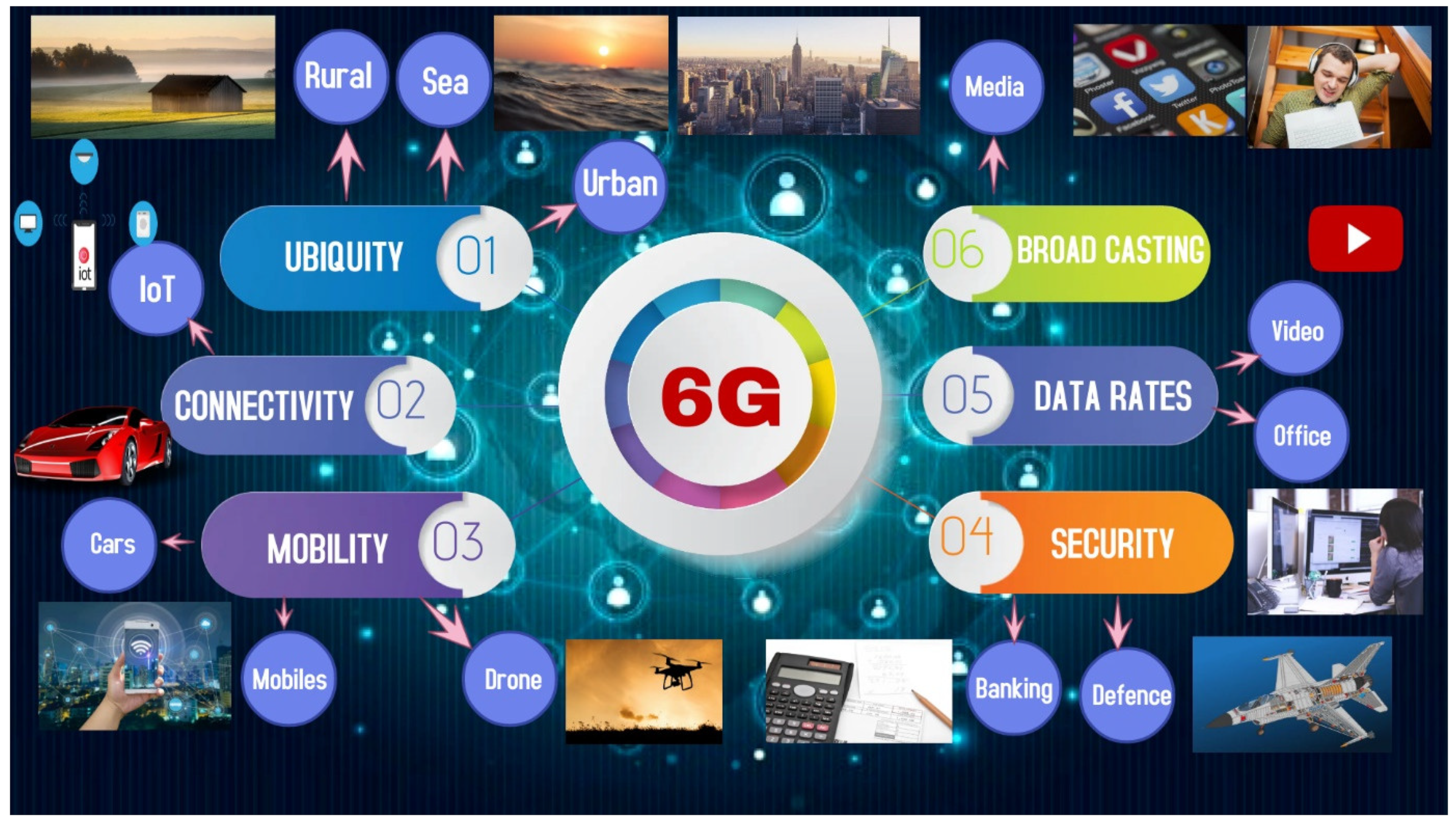
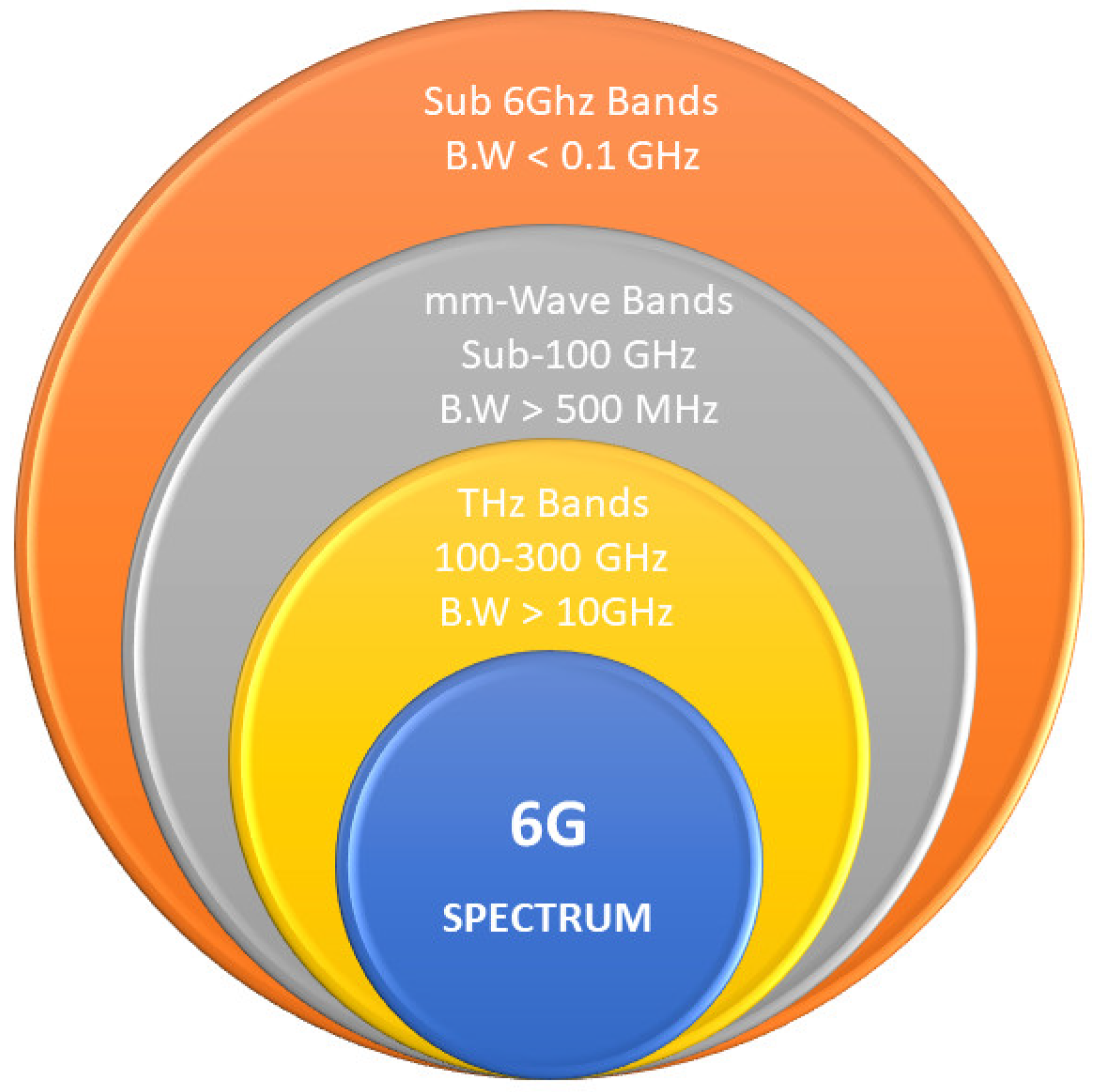

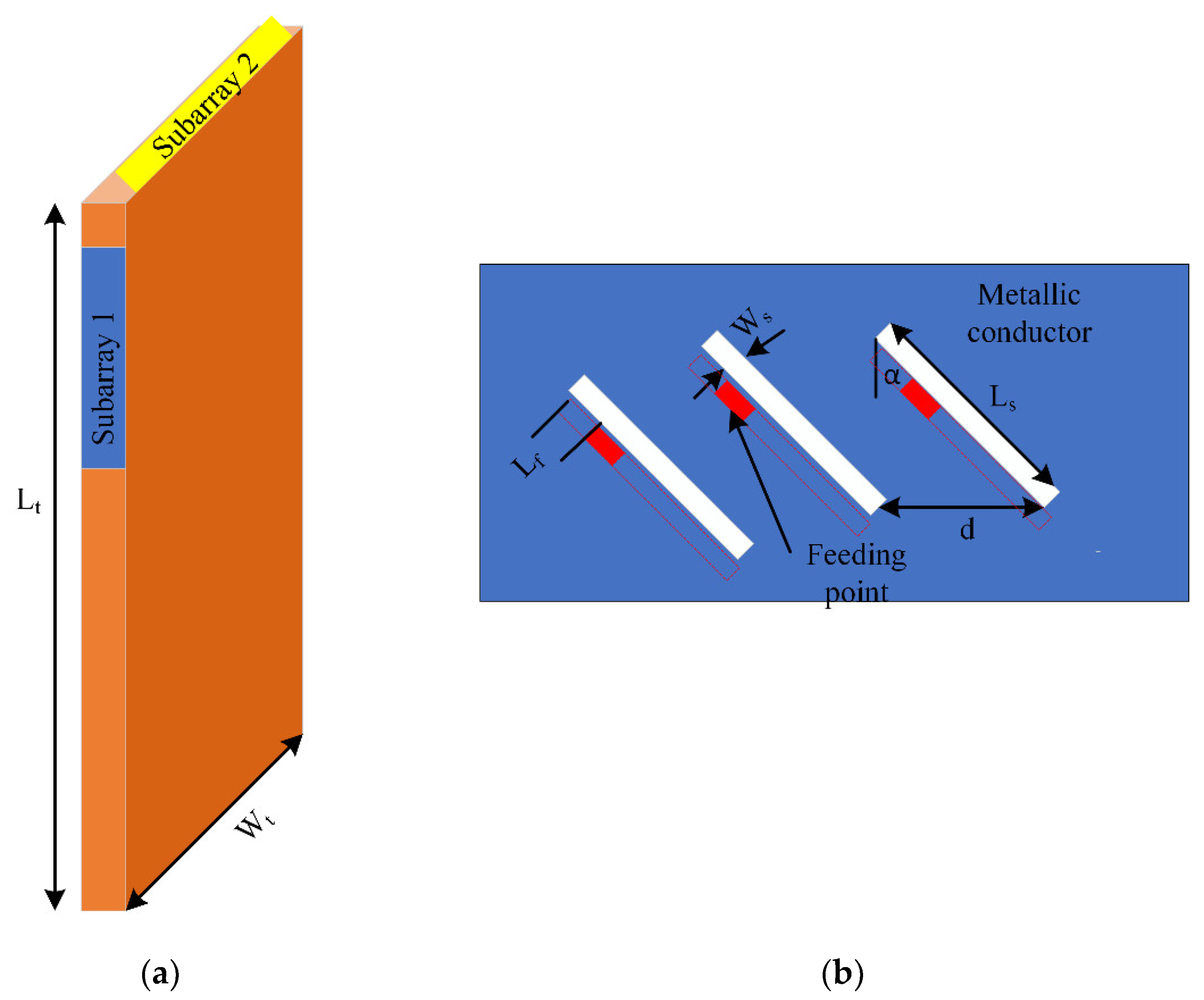
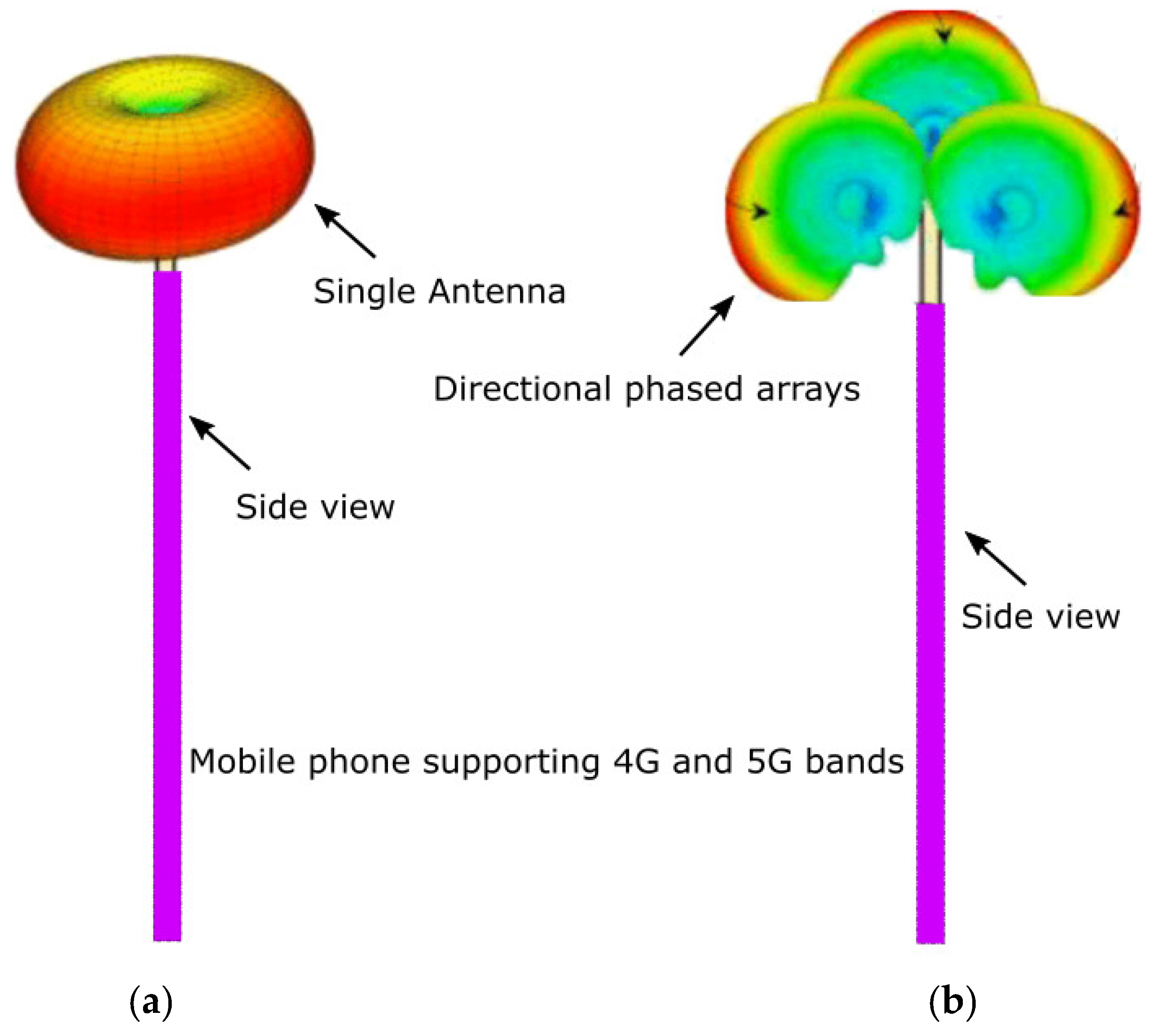



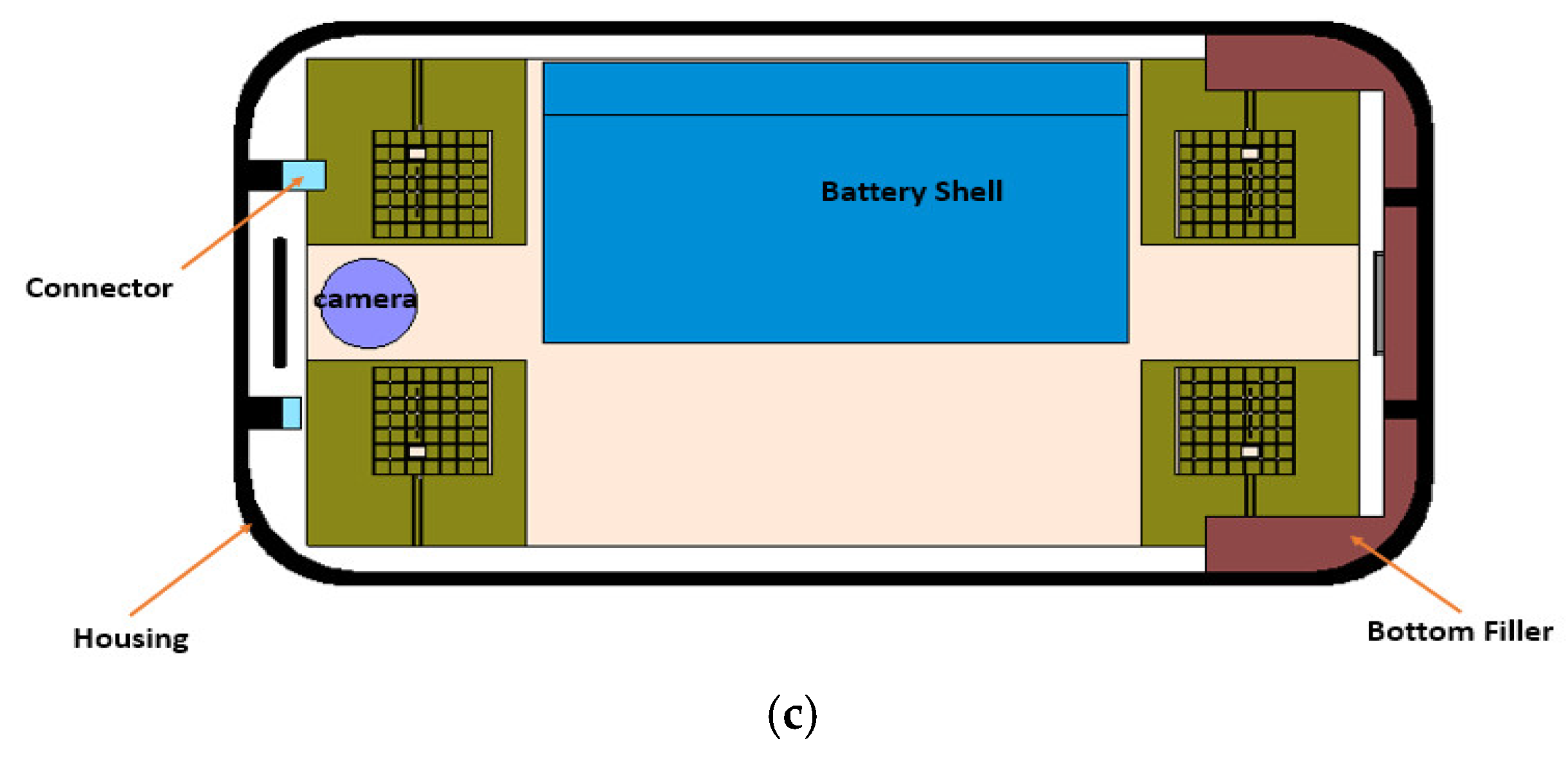
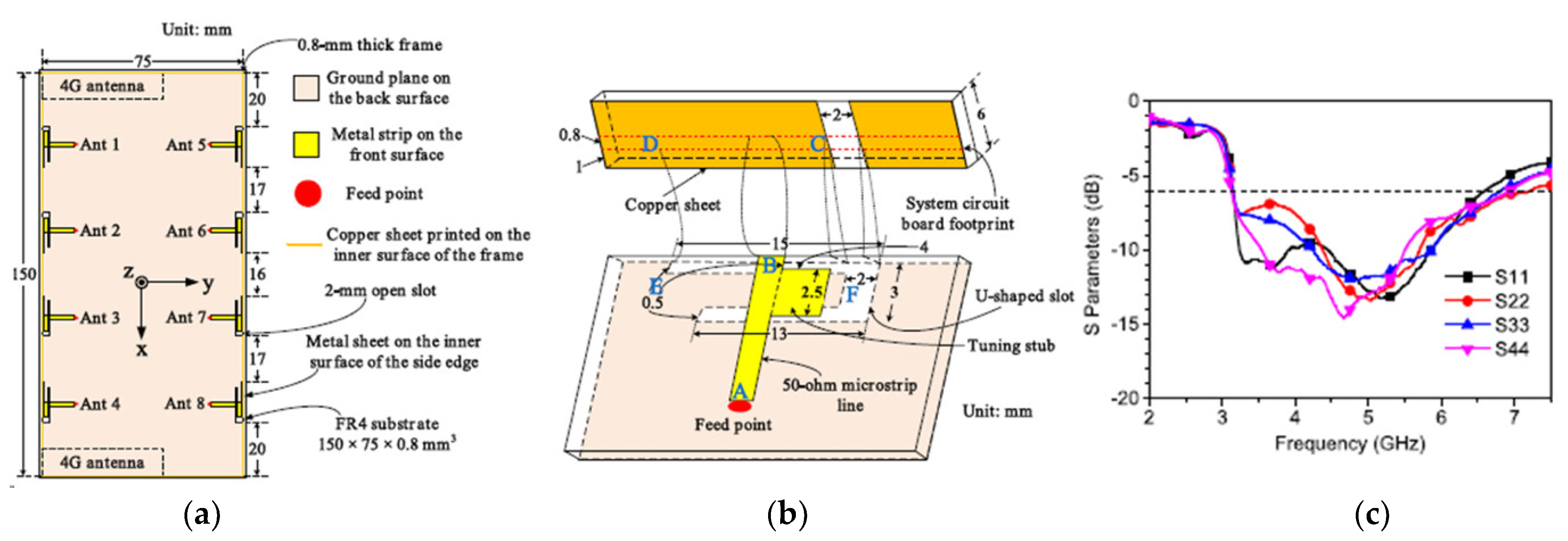







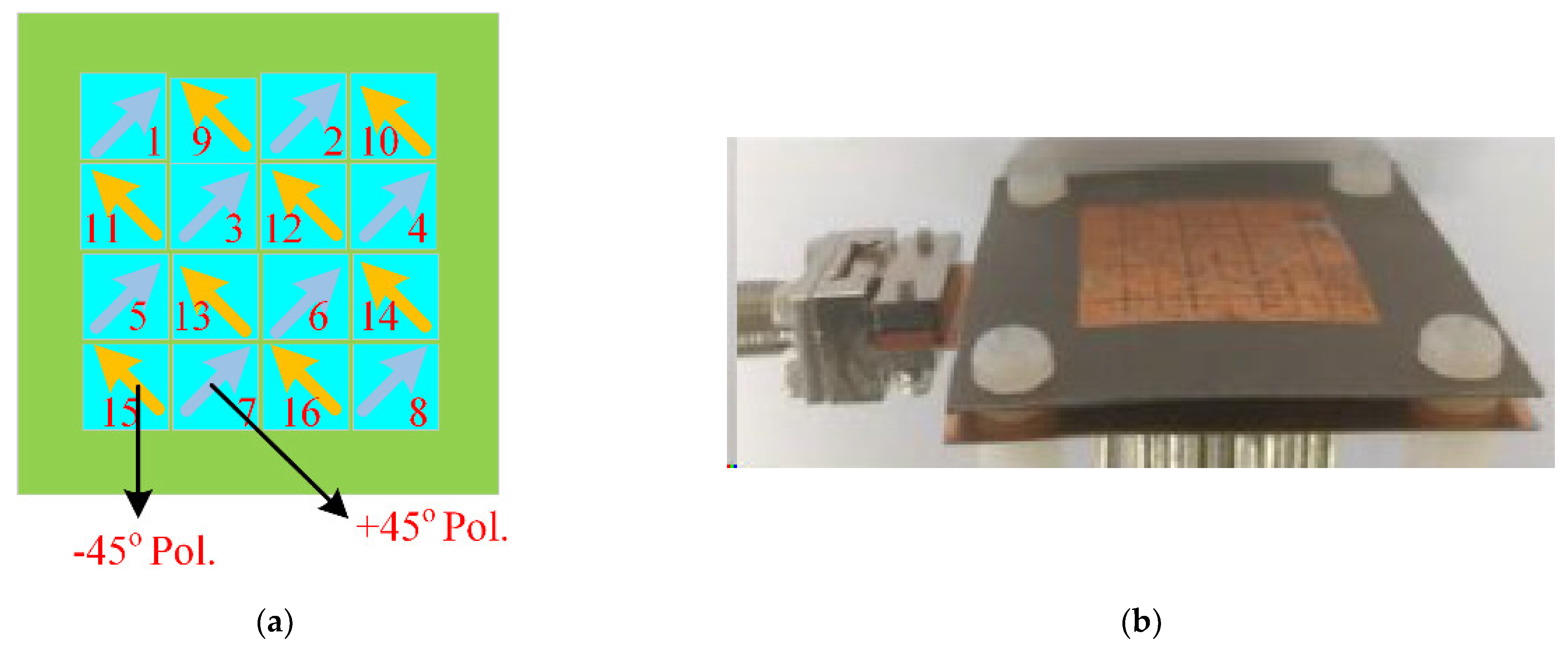

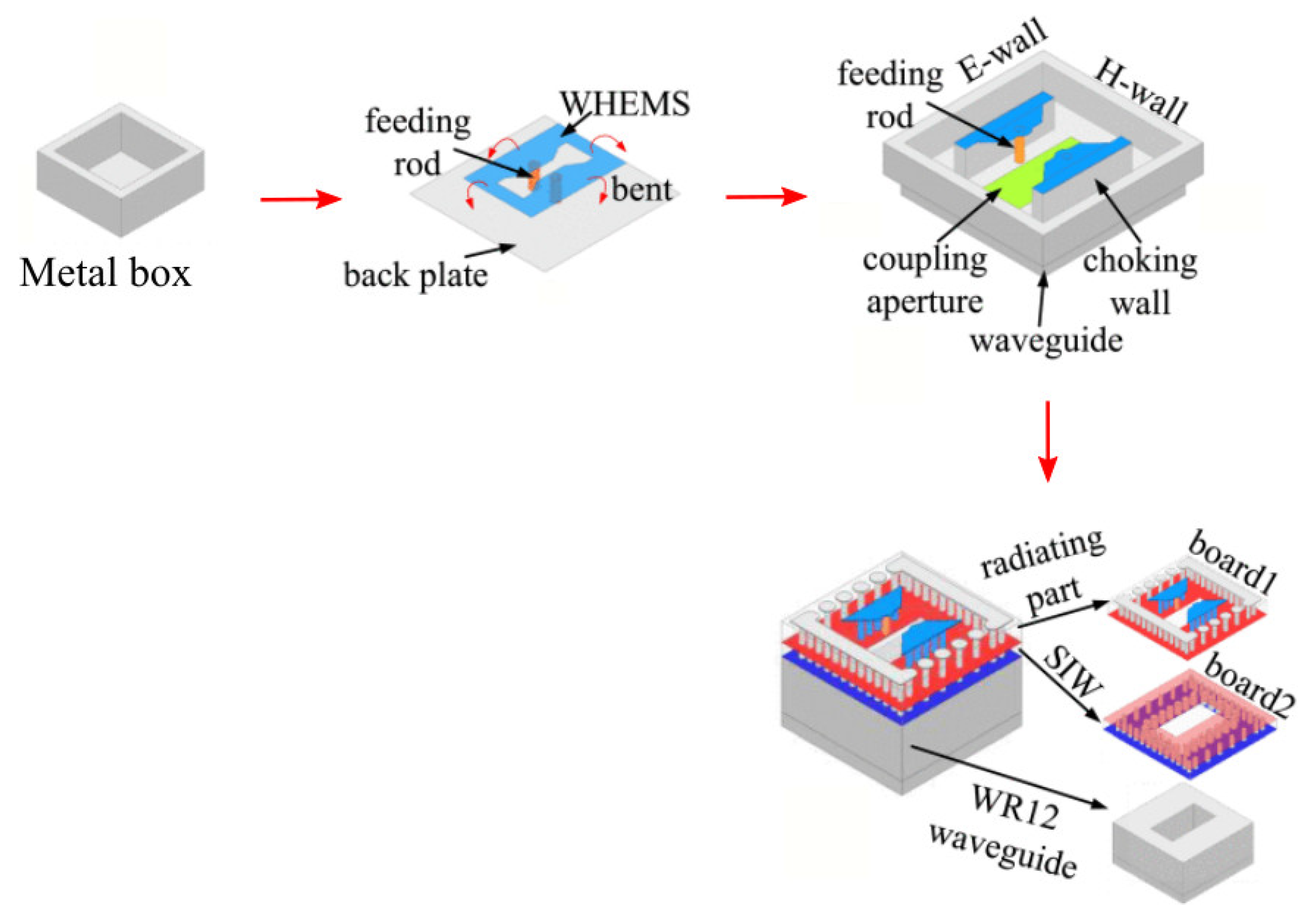

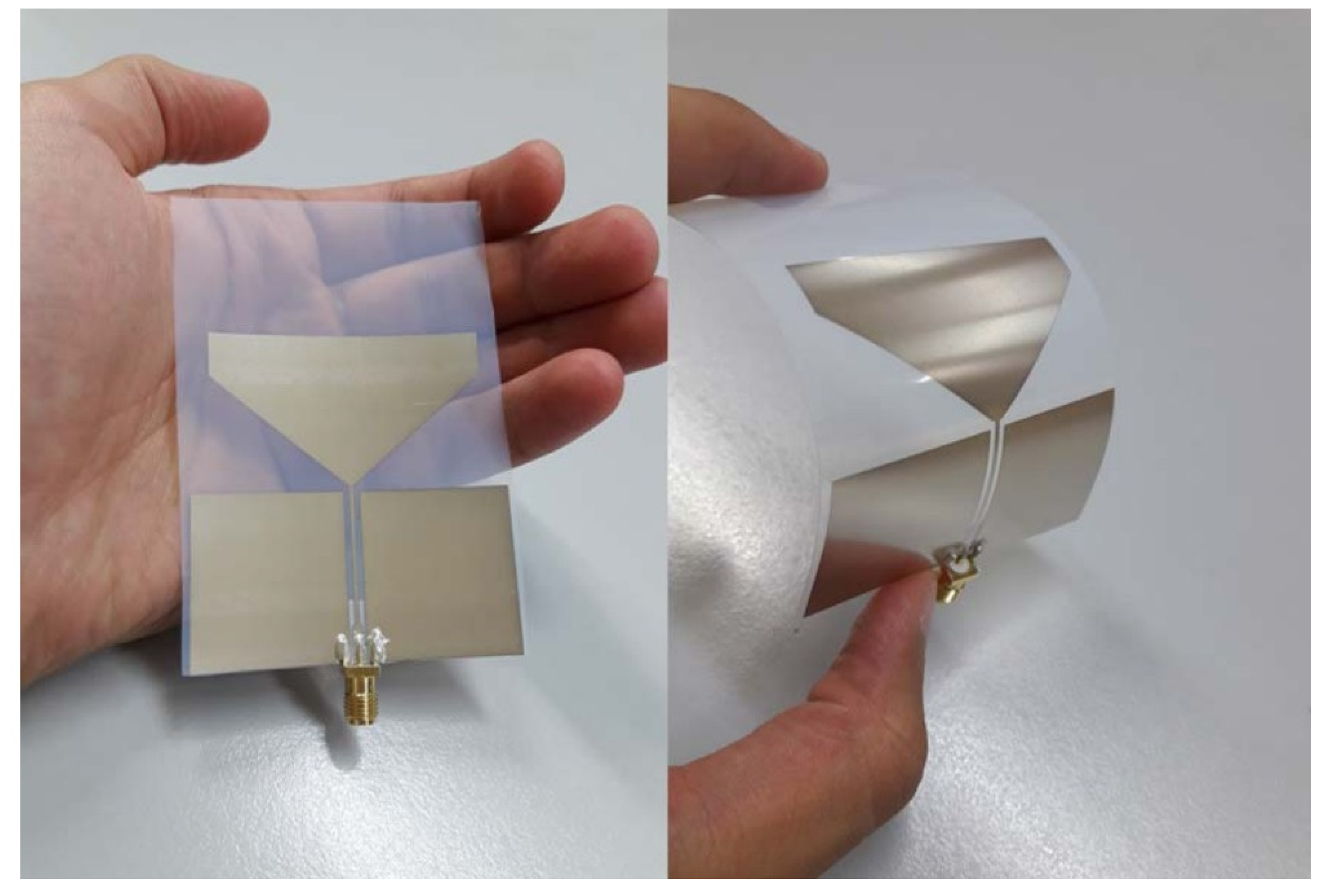
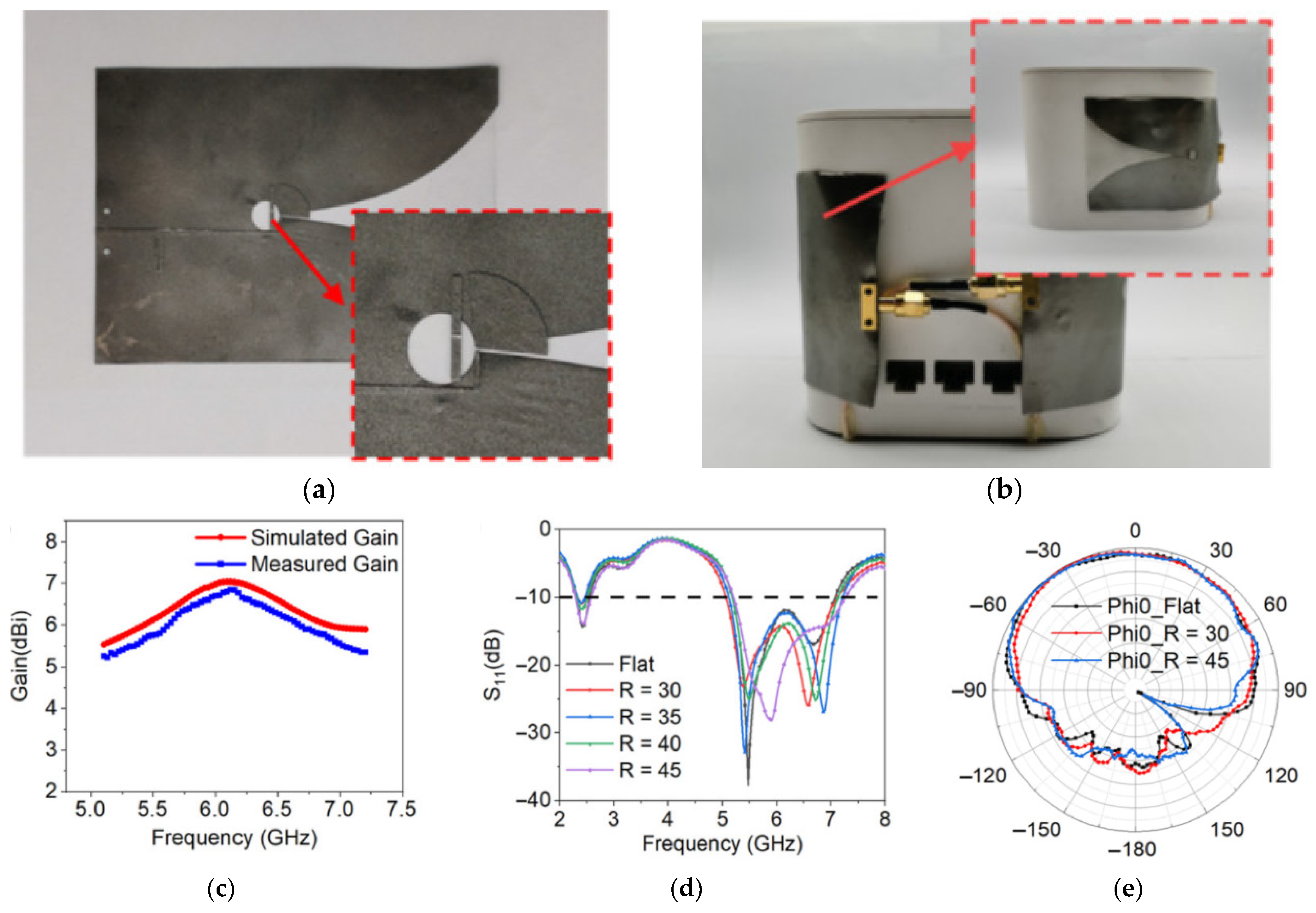

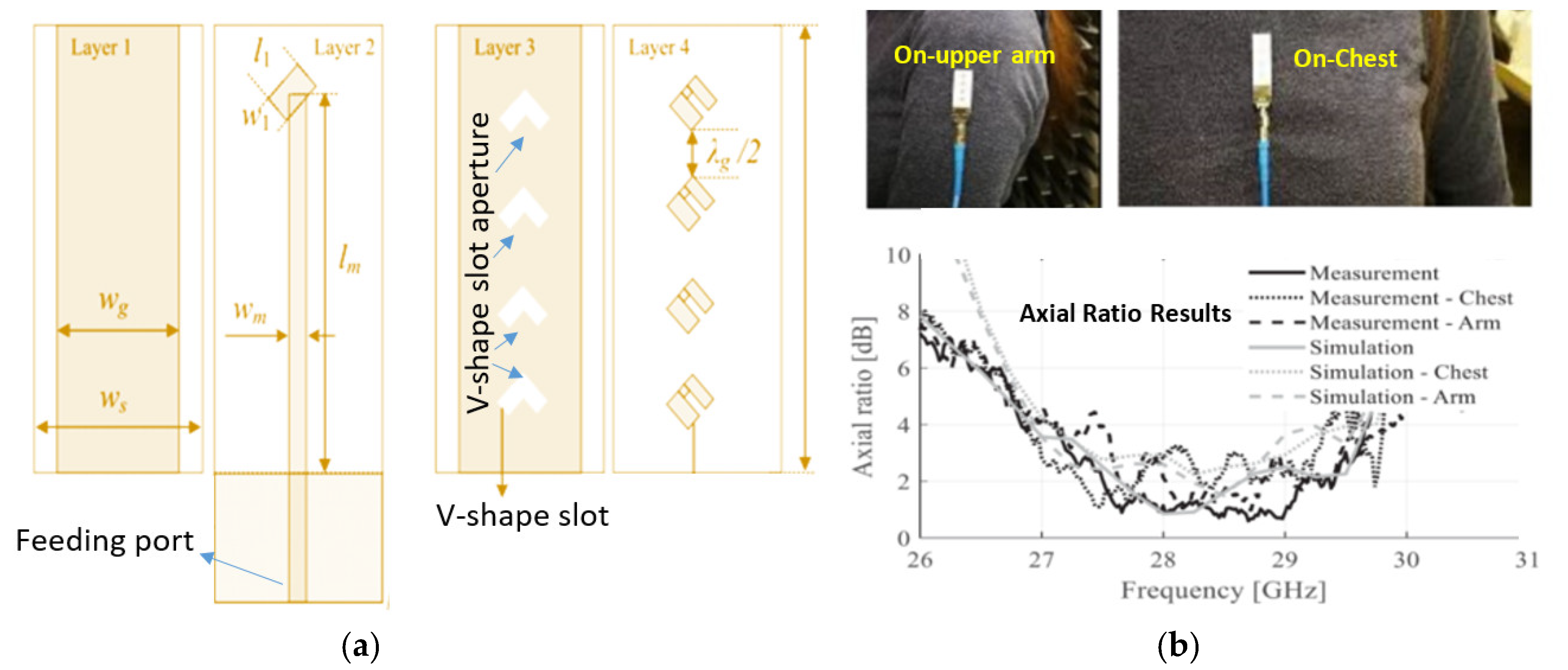
| Towards 6G Communication: 5G Antennas, Arrays, and Wearable Devices | |||
|---|---|---|---|
| 1. Introduction | |||
| 2. Towards 6G Communication | 2.1. Key Features | ||
| 2.2. 6G Frequency Spectrum | |||
| 3. 5G Antennas, Arrays and Wearable Devices | 3.1. Antennas For 5G Handhold Devices | 3.1.1. 5G Antennas According to Operational Approach | Beam Steerable Antenna |
| Switchable Phase Array | |||
| Dual Polarized Antenna | |||
| 3.1.2. 5G Antennas According to The Operational Frequency Band | Sub- 6 GHz 5G Antennas | ||
| mm-wave Antennas | |||
| Sub-6GHz and mm-wave Antennas | |||
| 3.2. Antenna for Access Points | |||
| 3.3. Antennas at THz Frequency Bands | |||
| 3.4. 5G Wearable Antennas | 3.4.1. Sub-6GHz 5G Wearable Antennas | ||
| 3.4.2. mm-wave 5G Wearable Antennas | |||
| 4. Conclusions | |||
| Ref | Freq. (GHz) | Gain (dBi) | Isolation (dB) | X-Pol (dB) | Complicated | Remarks | |
|---|---|---|---|---|---|---|---|
| [52] | 8.16–11.15 | 1.37 × 1.37 × 0.222 | 13 | 39 | 42 | High |
|
| [53] | 30.1–30.9 | 3.2 × 3.2 × 0.1 | 3.8 | 20 | 25 | High |
|
| [54] | 2.4–4.12 | 1.75 × 1.75 × 0.02 | 8.6 | 35 | 20 | Medium |
|
| [55] | 27.5–29.5 | 2.7 × 2.54 × 0.10 | 7.48 | 18 | 10 | High |
|
| [56] | 1.88–2.9 | 1.73 × 1.03 × 0.144 | 9.4 | 30 | 20 | High |
|
| [48] | 1.86–2.97 | 0.93 × 0.93 × 0.004 | 4.5 | 26 | 28 | High |
|
| [30] | 25.5–30 | 0.83 × 0.83 × 0.03 | 11 | 40 | 40 | Low |
|
| Ref. | MIMO Order | Phone Board (mm2) | Thickness (mm) | ECC | Dual-Pol. (X.P) | Isolation (dB) | Gain (dBi) | Eff. (%) | Remarks |
|---|---|---|---|---|---|---|---|---|---|
| [49] | 8 | 136 × 68 | 5 | 0.15 | yes (15) | 12.5 | NA | 55 |
|
| [59] | 8 | 150 × 75 | 6.2 | 0.08 | No | 11 | NA | 42 |
|
| [57] | 8 | 150 × 80 | 0.8 | 0.05 | No | 17.5 | NA | 62 |
|
| [58] | 8 | NA | 1.93 | NA | Yes (18.3) | 20 | 7 | 90 |
|
| [30] | 8 | 100 × 60 | 0.4 | 0.001 | Yes (40) | 40 | 11 | 90 |
|
| [60] | 8 | 158 × 77.8 | 0.38 | 0.001 | No | 16/25 | 2/7 |
|
| Ref. | Size of Board mm3 | Freq. (GHz) | MIMO | Supporting mmWave | No. of Ports | Gain at mmWave | Isolation (dB) |
|---|---|---|---|---|---|---|---|
| [100] | 104 × 104 × 0.51 | 2.45, 2.6, 5.2, 24, 28 | Yes | Yes | 4-LB 4-UB | 11 | 16 |
| [101] | 31.2 × 31.2 × 1.757 | 24 | Yes | Yes | 8-UB | 6.4 | 15 |
| [102] | 40 × 25 × 1.524 | 5.2, 24 | No | Yes | 1-LB 1-UB | 7 | 35 |
| [103] | 15 × 15 × 0.48 | 2.4, 5.2, 60 | No | Yes | 1-LB 1-UB | 15 | NA |
| [104] | 35 × 33 × 0.24 | 2.45, 5.2, 5.8, 60 | No | Yes | 1-LB 1-UB | 6 | 20 |
| [99] | 90 × 90 × 9.5 | 2.6, 26 | Yes | Yes | 1-LB 4-UB | 16 | 15 |
| [97] | 40 × 40 × 3.8 | 3.5, 28 | No | Yes | 1-LB 16-UB | 13 | NA |
| [74] | 150 × 75 × 0.51 | 0.8, 1.9–2.6, 28 | Yes | Yes | 4-LB 4-UB | 9.5 | 10 |
| [69] | 140 × 70 × 5.8 | 0.9, 1.8, 2.1, 2.3, 2.5, 3.5 | Yes | No | 8-LB | -- | 10 |
| [105] | 64 × 64 × 1.52 | 2.45, 5.2, 2.3–3.8 | Yes | No | 8-LB | -- | 9 |
| [65] | 130 × 70 × 0.78 | 26–40 | Yes | Yes | 4-UB | 8 | 20 |
Publisher’s Note: MDPI stays neutral with regard to jurisdictional claims in published maps and institutional affiliations. |
© 2022 by the authors. Licensee MDPI, Basel, Switzerland. This article is an open access article distributed under the terms and conditions of the Creative Commons Attribution (CC BY) license (https://creativecommons.org/licenses/by/4.0/).
Share and Cite
Ikram, M.; Sultan, K.; Lateef, M.F.; Alqadami, A.S.M. A Road towards 6G Communication—A Review of 5G Antennas, Arrays, and Wearable Devices. Electronics 2022, 11, 169. https://doi.org/10.3390/electronics11010169
Ikram M, Sultan K, Lateef MF, Alqadami ASM. A Road towards 6G Communication—A Review of 5G Antennas, Arrays, and Wearable Devices. Electronics. 2022; 11(1):169. https://doi.org/10.3390/electronics11010169
Chicago/Turabian StyleIkram, Muhammad, Kamel Sultan, Muhammad Faisal Lateef, and Abdulrahman S. M. Alqadami. 2022. "A Road towards 6G Communication—A Review of 5G Antennas, Arrays, and Wearable Devices" Electronics 11, no. 1: 169. https://doi.org/10.3390/electronics11010169
APA StyleIkram, M., Sultan, K., Lateef, M. F., & Alqadami, A. S. M. (2022). A Road towards 6G Communication—A Review of 5G Antennas, Arrays, and Wearable Devices. Electronics, 11(1), 169. https://doi.org/10.3390/electronics11010169









